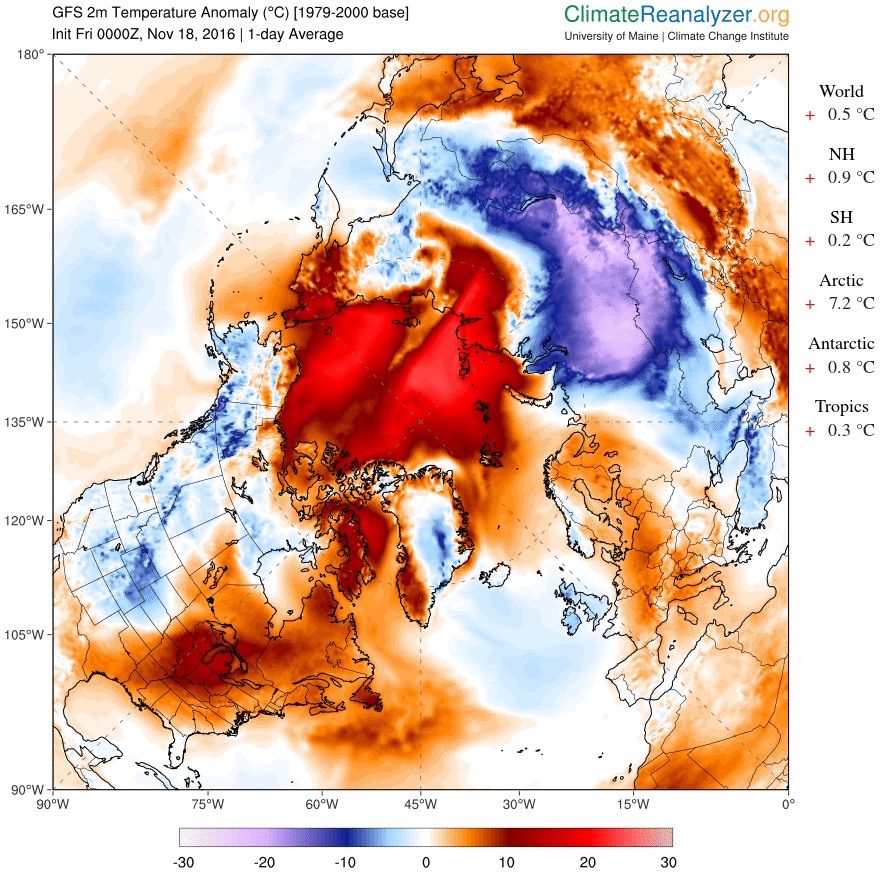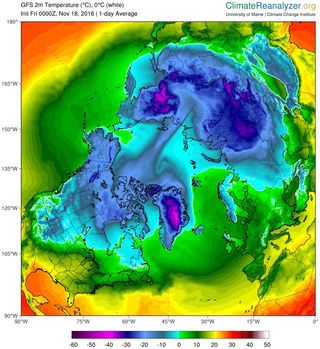Santa's Sweltering: North Pole Soars 36 Degrees Above Normal

Santa may need to take off some of his jolly layers this Christmas: The North Pole — the northernmost point on the globe (where Mr. Claus lives) — is more than 36 degrees Fahrenheit (20 degrees Celsius) warmer than it has been in past decades, a new report finds.
Moreover, the entire Arctic, a region that includes the North Pole, is almost 13 F (7.2 C) warmer today (Nov. 18) than in past years, the report found.
These analyses come from Sean Birkel, a research assistant professor at the University of Maine's Climate Change Institute. He updates the temperature difference for the Arctic every day on ClimateReanalyzer.org, saying he hopes to raise awareness about how the Arctic is heating up overall, in some places as much as 36 F above normal. [8 Ways Global Warming Is Already Changing the World]
Birkel calculates his forecast temperature anomaly maps for the Arctic by comparing the current day's values against a 1979 to 2000 climate baseline period for the same day of the year. The method uses U.S. weather forecast and reanalysis models, he said.
The finding is no surprise to climate scientists who have kept a close eye on the Arctic for years.For most of 2016, the Arctic has had record-low sea iceand record-high temperatures, said Jennifer Francis, a research professor in the Department of Marine and Coastal Sciences at Rutgers University in New Jersey.
"The Arctic has been in uncharted territory pretty much all year long, ever since last fall," Francis told Live Science.
Though a variety of factors are likely behind the record-breaking temperature spikes, overall, "the broader background is that the climate is warming, [and] the Arctic is warming very much so, more so than any other part of the globe," Birkel said.
Sign up for the Live Science daily newsletter now
Get the world’s most fascinating discoveries delivered straight to your inbox.
Ice sheets reflect the sun's energy back into space, but as ice melts, the newly exposed ocean absorbs the sun's heat instead. As the water warms, it releases water vapor, which traps heat within the Earth's atmosphere. The vapor also leads to cloud formation, which traps even more heat, Francis said.
In turn, the warmer ocean and increased water vapor and clouds further decrease sea-ice cover, which exacerbates the problem, she said.
"The loss of the sea ice, the increased melting of the Greenland Ice Sheet, the thawing of permafrost, the changes in the weather patterns, the rising sea level — it's all consistent with our expectations for the response of the climate system to increases in greenhouse gases," Francis said. "It's been totally expected. What's not expected is how fast it's been happening."

Arctic effects
The record-low sea ice doesn't just send temperatures higher, but it also is causing a frigid winter in central Asia, Francis said. That's because the jet stream (a fast-moving air current) tends to swing northward in the region north of Scandinavia and western Russia. When the sea ice in that region the Arctic Ocean is lost, the warmth tends to intensify the jet stream's northward swing, said Francis, who credited Judah Cohen, a forecaster with Atmospheric and Environmental Research, for figuring out the effect. [Images of Melt: Earth's Vanishing Ice]
That extra swing allows the jet stream to dip farther south in regions east of Scandinavia and western Russia, just over central Asia, she said.
"That allows the cold air from the Arctic to plunge farther south, and it tends to create snowfall earlier in the fall, which is exactly what we've seen this year," Francis said. "In fact, it's been a record amount of snowfall in northern Siberia. And when you get snow on the ground there, that makes it colder, and that intensifies the southward dip even more."
Daniel Swain, a climate scientist at the University of California, Los Angeles, noted this effect on Twitter, saying, "Extraordinary #Arctic warmth and #Siberia cold, likely linked to record-low #seaice, expected to persist into December, per model forecasts."
The loss of sea ice will likely harm animals that depend on it for survival, including the polar bear, Francis said. In addition, researchers are learning that increases in sea-surface temperatures are changing the type of plankton that live in the water column, which could alter the entire food web, she said.
Perhaps these climate changes will prompt people to take action to slow planetary warming, Francis said.
"We are doing irreparable damage to our planet," Francis said. "As a society, we need to get a grip and get serious about doing something about it."
Original article on Live Science.

Laura is the archaeology and Life's Little Mysteries editor at Live Science. She also reports on general science, including paleontology. Her work has appeared in The New York Times, Scholastic, Popular Science and Spectrum, a site on autism research. She has won multiple awards from the Society of Professional Journalists and the Washington Newspaper Publishers Association for her reporting at a weekly newspaper near Seattle. Laura holds a bachelor's degree in English literature and psychology from Washington University in St. Louis and a master's degree in science writing from NYU.











